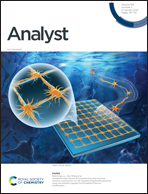Alizarin-based molecular probes for the detection of hydrogen peroxide and peroxynitrite†
Abstract
Phenol fluorophores are a large family of fluorophores, which have attracted more and more attention in the design of probes. Using the self-assembly of aromatic boronic acid with Alizarin Red S (ARS) and Gallein (GAL), the novel chemosensors ARS–CBA and GAL–CBA were provided for hydrogen peroxide (H2O2), which demonstrated their ability to detect H2O2 with indicator displacement assay (IDA) by colorimetric and electrochemical measurements. After ARS–CBA and GAL–CBA reacted with H2O2, the systems displayed a red-shifted visible color change in aqueous media and off-on electrochemical signals showing generation of phenol. The chemosensor ARS–CBA also had good performance in fluorometric measurements and turn-off fluorescent response indicated removal of aromatic boronic acid. In addition, a designed near-infrared (NIR) dual-modal fluorescent probe alizarin blue S (ABS) was used for peroxynitrite (ONOO−) with a visible colorimetric change in dimethyl sulfoxide (DMSO) and “on–off” fluorescent response indicating the oxidation of hydroxyl. The flexible Phenol fluorophores are allowed to prepare multiple fluorescent probes towards H2O2 or ONOO− for environmental and physiological applications.



 Please wait while we load your content...
Please wait while we load your content...